Job Design Analysis: Benefits for Employers, Not Employees
VerifiedAdded on 2019/11/19
|9
|2389
|228
Essay
AI Summary
This essay critically analyzes the benefits of job design to employers, arguing that the primary advantages accrue to the organization rather than the employees. It defines job design as the process of structuring tasks, duties, roles, and responsibilities to align with employee skills and organizational goals. The essay explores techniques such as job enlargement, job enrichment, and job rotation, highlighting how these methods enhance employee performance and productivity, ultimately benefiting employers through reduced absenteeism and increased output. The discussion references key concepts such as the Job Characteristics Theory and motivational theories like Maslow's hierarchy of needs, illustrating how job design can be leveraged to motivate employees and achieve organizational objectives. The essay concludes that while job design may improve employee satisfaction and engagement, the ultimate beneficiaries are employers, who gain from improved efficiency, production outcomes, and a more motivated workforce, often without commensurate financial rewards for the employees. The essay draws on various academic sources to support its arguments.

Management Principles 1
Job Design Benefits Employers, not Workers
Job Design Benefits Employers, not Workers
Paraphrase This Document
Need a fresh take? Get an instant paraphrase of this document with our AI Paraphraser
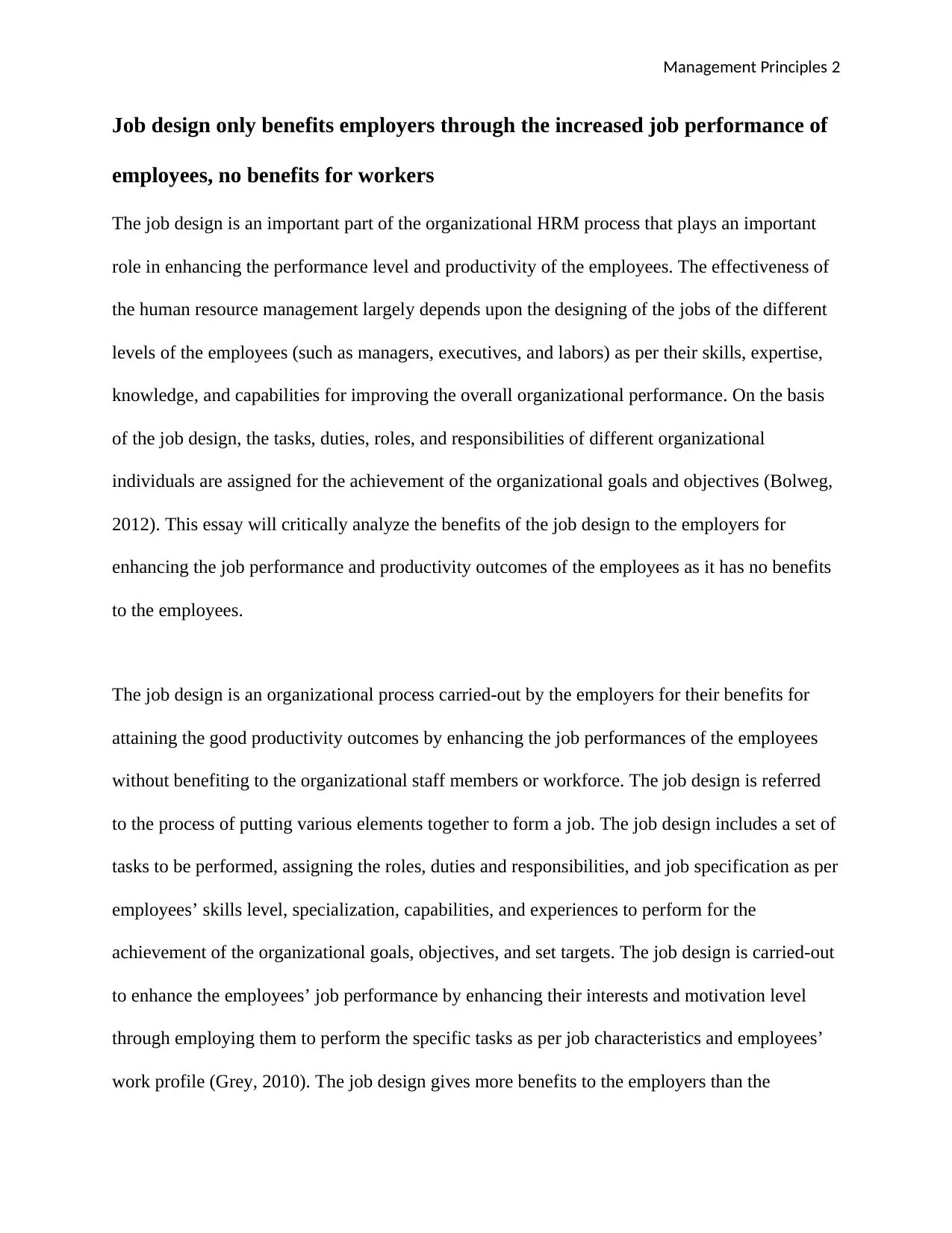
Management Principles 2
Job design only benefits employers through the increased job performance of
employees, no benefits for workers
The job design is an important part of the organizational HRM process that plays an important
role in enhancing the performance level and productivity of the employees. The effectiveness of
the human resource management largely depends upon the designing of the jobs of the different
levels of the employees (such as managers, executives, and labors) as per their skills, expertise,
knowledge, and capabilities for improving the overall organizational performance. On the basis
of the job design, the tasks, duties, roles, and responsibilities of different organizational
individuals are assigned for the achievement of the organizational goals and objectives (Bolweg,
2012). This essay will critically analyze the benefits of the job design to the employers for
enhancing the job performance and productivity outcomes of the employees as it has no benefits
to the employees.
The job design is an organizational process carried-out by the employers for their benefits for
attaining the good productivity outcomes by enhancing the job performances of the employees
without benefiting to the organizational staff members or workforce. The job design is referred
to the process of putting various elements together to form a job. The job design includes a set of
tasks to be performed, assigning the roles, duties and responsibilities, and job specification as per
employees’ skills level, specialization, capabilities, and experiences to perform for the
achievement of the organizational goals, objectives, and set targets. The job design is carried-out
to enhance the employees’ job performance by enhancing their interests and motivation level
through employing them to perform the specific tasks as per job characteristics and employees’
work profile (Grey, 2010). The job design gives more benefits to the employers than the
Job design only benefits employers through the increased job performance of
employees, no benefits for workers
The job design is an important part of the organizational HRM process that plays an important
role in enhancing the performance level and productivity of the employees. The effectiveness of
the human resource management largely depends upon the designing of the jobs of the different
levels of the employees (such as managers, executives, and labors) as per their skills, expertise,
knowledge, and capabilities for improving the overall organizational performance. On the basis
of the job design, the tasks, duties, roles, and responsibilities of different organizational
individuals are assigned for the achievement of the organizational goals and objectives (Bolweg,
2012). This essay will critically analyze the benefits of the job design to the employers for
enhancing the job performance and productivity outcomes of the employees as it has no benefits
to the employees.
The job design is an organizational process carried-out by the employers for their benefits for
attaining the good productivity outcomes by enhancing the job performances of the employees
without benefiting to the organizational staff members or workforce. The job design is referred
to the process of putting various elements together to form a job. The job design includes a set of
tasks to be performed, assigning the roles, duties and responsibilities, and job specification as per
employees’ skills level, specialization, capabilities, and experiences to perform for the
achievement of the organizational goals, objectives, and set targets. The job design is carried-out
to enhance the employees’ job performance by enhancing their interests and motivation level
through employing them to perform the specific tasks as per job characteristics and employees’
work profile (Grey, 2010). The job design gives more benefits to the employers than the
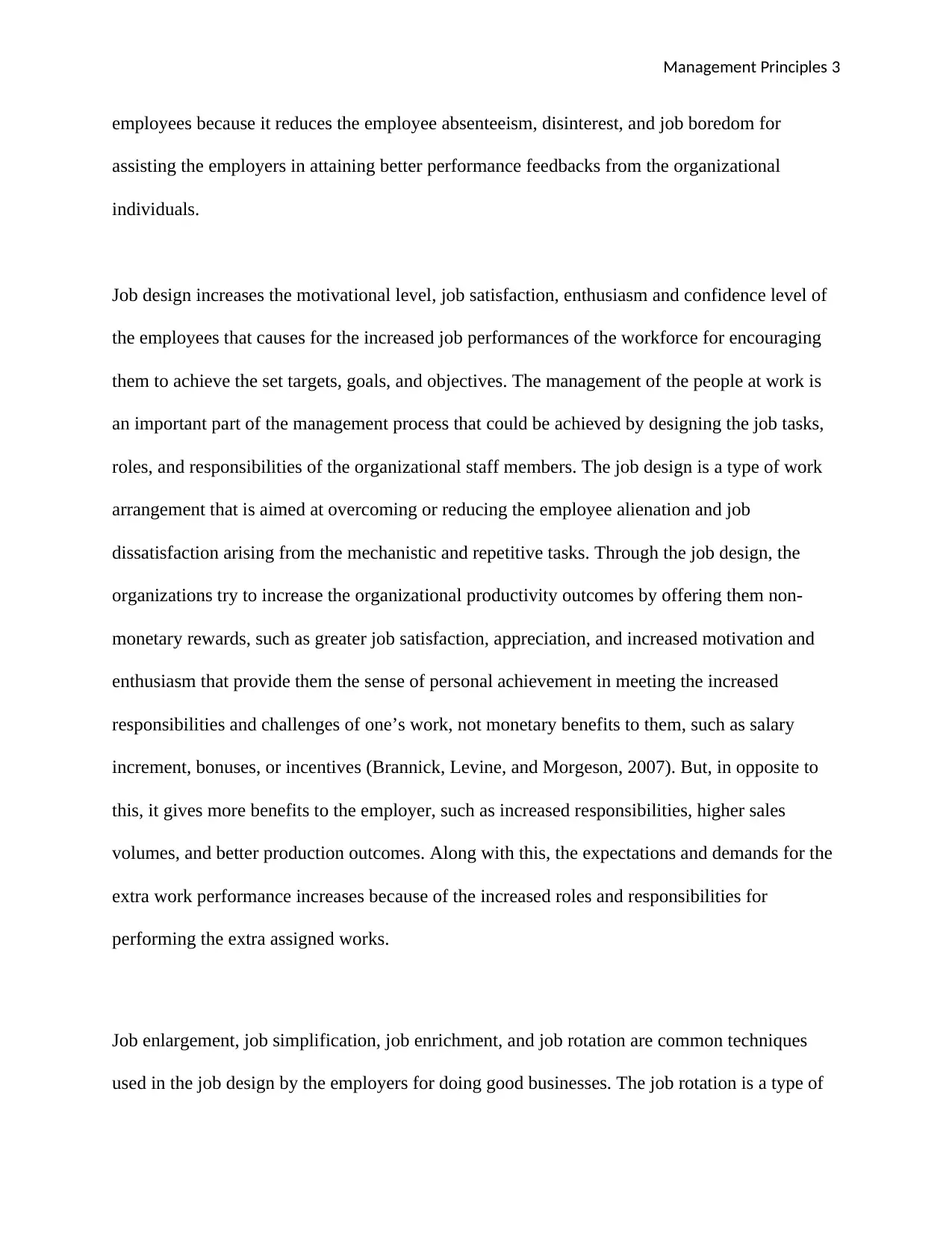
Management Principles 3
employees because it reduces the employee absenteeism, disinterest, and job boredom for
assisting the employers in attaining better performance feedbacks from the organizational
individuals.
Job design increases the motivational level, job satisfaction, enthusiasm and confidence level of
the employees that causes for the increased job performances of the workforce for encouraging
them to achieve the set targets, goals, and objectives. The management of the people at work is
an important part of the management process that could be achieved by designing the job tasks,
roles, and responsibilities of the organizational staff members. The job design is a type of work
arrangement that is aimed at overcoming or reducing the employee alienation and job
dissatisfaction arising from the mechanistic and repetitive tasks. Through the job design, the
organizations try to increase the organizational productivity outcomes by offering them non-
monetary rewards, such as greater job satisfaction, appreciation, and increased motivation and
enthusiasm that provide them the sense of personal achievement in meeting the increased
responsibilities and challenges of one’s work, not monetary benefits to them, such as salary
increment, bonuses, or incentives (Brannick, Levine, and Morgeson, 2007). But, in opposite to
this, it gives more benefits to the employer, such as increased responsibilities, higher sales
volumes, and better production outcomes. Along with this, the expectations and demands for the
extra work performance increases because of the increased roles and responsibilities for
performing the extra assigned works.
Job enlargement, job simplification, job enrichment, and job rotation are common techniques
used in the job design by the employers for doing good businesses. The job rotation is a type of
employees because it reduces the employee absenteeism, disinterest, and job boredom for
assisting the employers in attaining better performance feedbacks from the organizational
individuals.
Job design increases the motivational level, job satisfaction, enthusiasm and confidence level of
the employees that causes for the increased job performances of the workforce for encouraging
them to achieve the set targets, goals, and objectives. The management of the people at work is
an important part of the management process that could be achieved by designing the job tasks,
roles, and responsibilities of the organizational staff members. The job design is a type of work
arrangement that is aimed at overcoming or reducing the employee alienation and job
dissatisfaction arising from the mechanistic and repetitive tasks. Through the job design, the
organizations try to increase the organizational productivity outcomes by offering them non-
monetary rewards, such as greater job satisfaction, appreciation, and increased motivation and
enthusiasm that provide them the sense of personal achievement in meeting the increased
responsibilities and challenges of one’s work, not monetary benefits to them, such as salary
increment, bonuses, or incentives (Brannick, Levine, and Morgeson, 2007). But, in opposite to
this, it gives more benefits to the employer, such as increased responsibilities, higher sales
volumes, and better production outcomes. Along with this, the expectations and demands for the
extra work performance increases because of the increased roles and responsibilities for
performing the extra assigned works.
Job enlargement, job simplification, job enrichment, and job rotation are common techniques
used in the job design by the employers for doing good businesses. The job rotation is a type of
⊘ This is a preview!⊘
Do you want full access?
Subscribe today to unlock all pages.

Trusted by 1+ million students worldwide
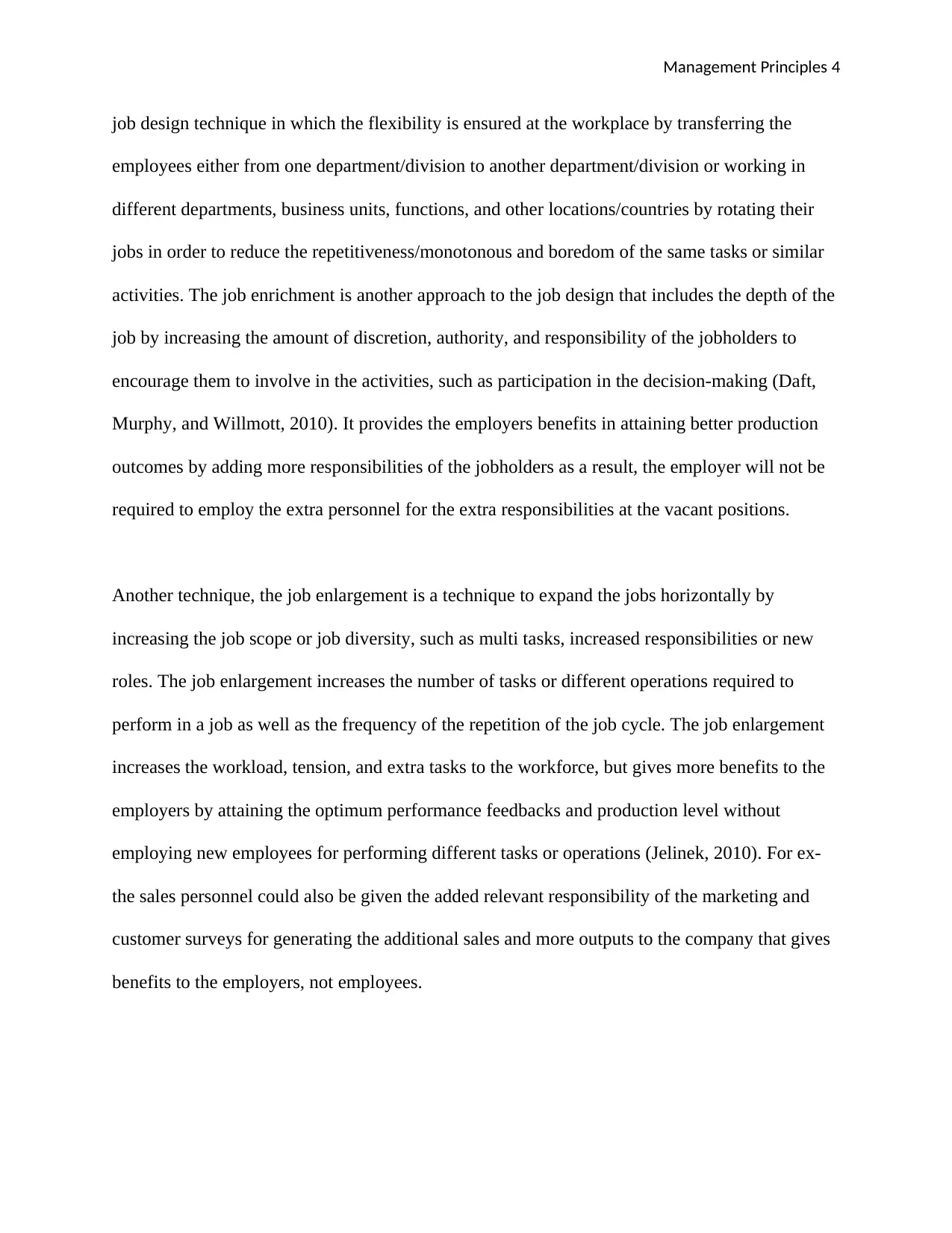
Management Principles 4
job design technique in which the flexibility is ensured at the workplace by transferring the
employees either from one department/division to another department/division or working in
different departments, business units, functions, and other locations/countries by rotating their
jobs in order to reduce the repetitiveness/monotonous and boredom of the same tasks or similar
activities. The job enrichment is another approach to the job design that includes the depth of the
job by increasing the amount of discretion, authority, and responsibility of the jobholders to
encourage them to involve in the activities, such as participation in the decision-making (Daft,
Murphy, and Willmott, 2010). It provides the employers benefits in attaining better production
outcomes by adding more responsibilities of the jobholders as a result, the employer will not be
required to employ the extra personnel for the extra responsibilities at the vacant positions.
Another technique, the job enlargement is a technique to expand the jobs horizontally by
increasing the job scope or job diversity, such as multi tasks, increased responsibilities or new
roles. The job enlargement increases the number of tasks or different operations required to
perform in a job as well as the frequency of the repetition of the job cycle. The job enlargement
increases the workload, tension, and extra tasks to the workforce, but gives more benefits to the
employers by attaining the optimum performance feedbacks and production level without
employing new employees for performing different tasks or operations (Jelinek, 2010). For ex-
the sales personnel could also be given the added relevant responsibility of the marketing and
customer surveys for generating the additional sales and more outputs to the company that gives
benefits to the employers, not employees.
job design technique in which the flexibility is ensured at the workplace by transferring the
employees either from one department/division to another department/division or working in
different departments, business units, functions, and other locations/countries by rotating their
jobs in order to reduce the repetitiveness/monotonous and boredom of the same tasks or similar
activities. The job enrichment is another approach to the job design that includes the depth of the
job by increasing the amount of discretion, authority, and responsibility of the jobholders to
encourage them to involve in the activities, such as participation in the decision-making (Daft,
Murphy, and Willmott, 2010). It provides the employers benefits in attaining better production
outcomes by adding more responsibilities of the jobholders as a result, the employer will not be
required to employ the extra personnel for the extra responsibilities at the vacant positions.
Another technique, the job enlargement is a technique to expand the jobs horizontally by
increasing the job scope or job diversity, such as multi tasks, increased responsibilities or new
roles. The job enlargement increases the number of tasks or different operations required to
perform in a job as well as the frequency of the repetition of the job cycle. The job enlargement
increases the workload, tension, and extra tasks to the workforce, but gives more benefits to the
employers by attaining the optimum performance feedbacks and production level without
employing new employees for performing different tasks or operations (Jelinek, 2010). For ex-
the sales personnel could also be given the added relevant responsibility of the marketing and
customer surveys for generating the additional sales and more outputs to the company that gives
benefits to the employers, not employees.
Paraphrase This Document
Need a fresh take? Get an instant paraphrase of this document with our AI Paraphraser
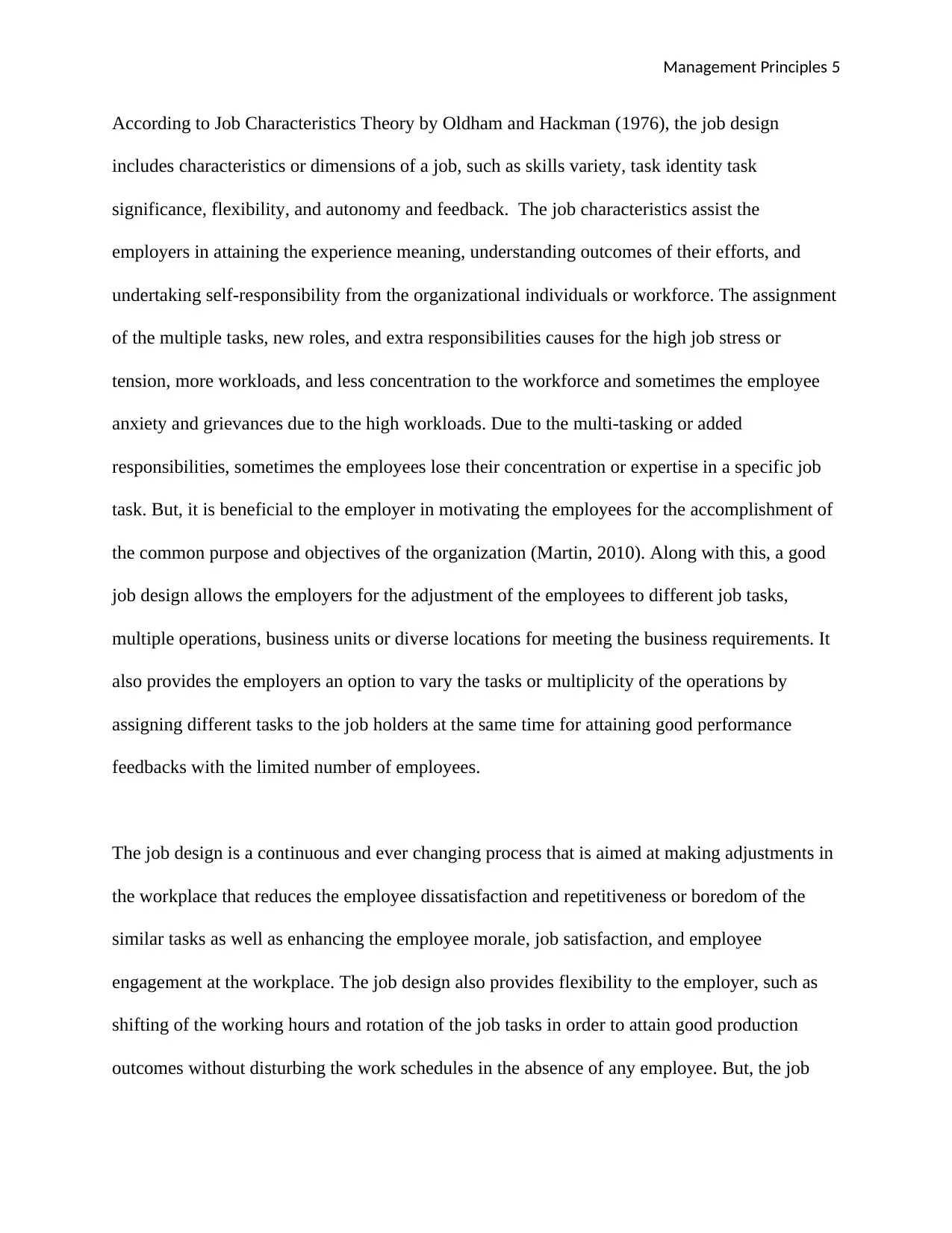
Management Principles 5
According to Job Characteristics Theory by Oldham and Hackman (1976), the job design
includes characteristics or dimensions of a job, such as skills variety, task identity task
significance, flexibility, and autonomy and feedback. The job characteristics assist the
employers in attaining the experience meaning, understanding outcomes of their efforts, and
undertaking self-responsibility from the organizational individuals or workforce. The assignment
of the multiple tasks, new roles, and extra responsibilities causes for the high job stress or
tension, more workloads, and less concentration to the workforce and sometimes the employee
anxiety and grievances due to the high workloads. Due to the multi-tasking or added
responsibilities, sometimes the employees lose their concentration or expertise in a specific job
task. But, it is beneficial to the employer in motivating the employees for the accomplishment of
the common purpose and objectives of the organization (Martin, 2010). Along with this, a good
job design allows the employers for the adjustment of the employees to different job tasks,
multiple operations, business units or diverse locations for meeting the business requirements. It
also provides the employers an option to vary the tasks or multiplicity of the operations by
assigning different tasks to the job holders at the same time for attaining good performance
feedbacks with the limited number of employees.
The job design is a continuous and ever changing process that is aimed at making adjustments in
the workplace that reduces the employee dissatisfaction and repetitiveness or boredom of the
similar tasks as well as enhancing the employee morale, job satisfaction, and employee
engagement at the workplace. The job design also provides flexibility to the employer, such as
shifting of the working hours and rotation of the job tasks in order to attain good production
outcomes without disturbing the work schedules in the absence of any employee. But, the job
According to Job Characteristics Theory by Oldham and Hackman (1976), the job design
includes characteristics or dimensions of a job, such as skills variety, task identity task
significance, flexibility, and autonomy and feedback. The job characteristics assist the
employers in attaining the experience meaning, understanding outcomes of their efforts, and
undertaking self-responsibility from the organizational individuals or workforce. The assignment
of the multiple tasks, new roles, and extra responsibilities causes for the high job stress or
tension, more workloads, and less concentration to the workforce and sometimes the employee
anxiety and grievances due to the high workloads. Due to the multi-tasking or added
responsibilities, sometimes the employees lose their concentration or expertise in a specific job
task. But, it is beneficial to the employer in motivating the employees for the accomplishment of
the common purpose and objectives of the organization (Martin, 2010). Along with this, a good
job design allows the employers for the adjustment of the employees to different job tasks,
multiple operations, business units or diverse locations for meeting the business requirements. It
also provides the employers an option to vary the tasks or multiplicity of the operations by
assigning different tasks to the job holders at the same time for attaining good performance
feedbacks with the limited number of employees.
The job design is a continuous and ever changing process that is aimed at making adjustments in
the workplace that reduces the employee dissatisfaction and repetitiveness or boredom of the
similar tasks as well as enhancing the employee morale, job satisfaction, and employee
engagement at the workplace. The job design also provides flexibility to the employer, such as
shifting of the working hours and rotation of the job tasks in order to attain good production
outcomes without disturbing the work schedules in the absence of any employee. But, the job

Management Principles 6
design creates new challenges with the increased responsibilities to the employees (Otman,
2009). The job design defines the work processes, shifting hours, job profile, tasks, roles and
responsibilities, but sometimes in the absence of an employee, the extra responsibility for
executing the tasks of that absence employee is shifted on the working employee that increases
the job stress and workload on him/her, but for this the working employees will get only the
similar pay, not given extra monetary benefit, such as bonus or added wages.
The job design includes designing or redesigning the duties, and roles of the employees with new
responsibilities designed to perform the job tasks effectively. The employers benefit from the job
design in the term of great output per workers, and lower operational costs. It also gives benefits
to the employers, such as flexibility and autonomy, high level of control, intellectual simulation
and wining confidence of the work, and direct contract with the potential customers. It assists the
employers in motivating the employees for giving better outputs, such as higher performance
levels, more production outcomes, increased sales outputs, and more customer attending and
good relationship with them because the motivated workforce will give extraordinary
performance and higher rates of production for the benefits of the employer (Dwivedula and
Jayakumar, 2010). Additionally, the employer communicates the organizational vision, mission,
goals, and objectives for allocating the job tasks or projects to different levels of employees
accordingly that will enhance their job satisfaction and workplace motivation that in turn will
encourage them to give valuable contribution with the best skills, knowledge, and capabilities for
the achievement of the set business targets and organizational objectives.
The motivational theories, like Maslow’s hierarchy needs theory could be linked to the job
design to motivate the employees for giving the extra job performance for the achievement of the
design creates new challenges with the increased responsibilities to the employees (Otman,
2009). The job design defines the work processes, shifting hours, job profile, tasks, roles and
responsibilities, but sometimes in the absence of an employee, the extra responsibility for
executing the tasks of that absence employee is shifted on the working employee that increases
the job stress and workload on him/her, but for this the working employees will get only the
similar pay, not given extra monetary benefit, such as bonus or added wages.
The job design includes designing or redesigning the duties, and roles of the employees with new
responsibilities designed to perform the job tasks effectively. The employers benefit from the job
design in the term of great output per workers, and lower operational costs. It also gives benefits
to the employers, such as flexibility and autonomy, high level of control, intellectual simulation
and wining confidence of the work, and direct contract with the potential customers. It assists the
employers in motivating the employees for giving better outputs, such as higher performance
levels, more production outcomes, increased sales outputs, and more customer attending and
good relationship with them because the motivated workforce will give extraordinary
performance and higher rates of production for the benefits of the employer (Dwivedula and
Jayakumar, 2010). Additionally, the employer communicates the organizational vision, mission,
goals, and objectives for allocating the job tasks or projects to different levels of employees
accordingly that will enhance their job satisfaction and workplace motivation that in turn will
encourage them to give valuable contribution with the best skills, knowledge, and capabilities for
the achievement of the set business targets and organizational objectives.
The motivational theories, like Maslow’s hierarchy needs theory could be linked to the job
design to motivate the employees for giving the extra job performance for the achievement of the
⊘ This is a preview!⊘
Do you want full access?
Subscribe today to unlock all pages.

Trusted by 1+ million students worldwide
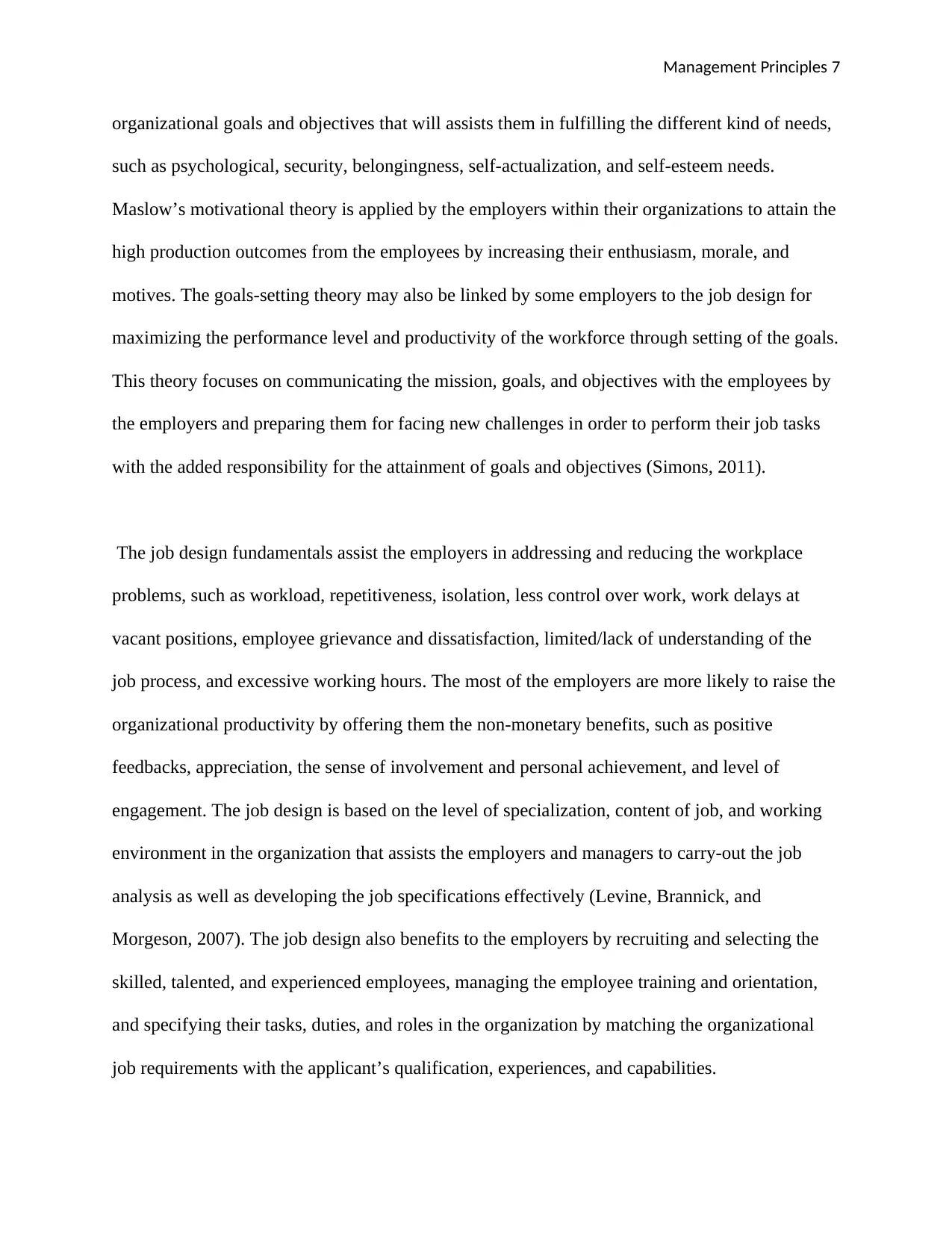
Management Principles 7
organizational goals and objectives that will assists them in fulfilling the different kind of needs,
such as psychological, security, belongingness, self-actualization, and self-esteem needs.
Maslow’s motivational theory is applied by the employers within their organizations to attain the
high production outcomes from the employees by increasing their enthusiasm, morale, and
motives. The goals-setting theory may also be linked by some employers to the job design for
maximizing the performance level and productivity of the workforce through setting of the goals.
This theory focuses on communicating the mission, goals, and objectives with the employees by
the employers and preparing them for facing new challenges in order to perform their job tasks
with the added responsibility for the attainment of goals and objectives (Simons, 2011).
The job design fundamentals assist the employers in addressing and reducing the workplace
problems, such as workload, repetitiveness, isolation, less control over work, work delays at
vacant positions, employee grievance and dissatisfaction, limited/lack of understanding of the
job process, and excessive working hours. The most of the employers are more likely to raise the
organizational productivity by offering them the non-monetary benefits, such as positive
feedbacks, appreciation, the sense of involvement and personal achievement, and level of
engagement. The job design is based on the level of specialization, content of job, and working
environment in the organization that assists the employers and managers to carry-out the job
analysis as well as developing the job specifications effectively (Levine, Brannick, and
Morgeson, 2007). The job design also benefits to the employers by recruiting and selecting the
skilled, talented, and experienced employees, managing the employee training and orientation,
and specifying their tasks, duties, and roles in the organization by matching the organizational
job requirements with the applicant’s qualification, experiences, and capabilities.
organizational goals and objectives that will assists them in fulfilling the different kind of needs,
such as psychological, security, belongingness, self-actualization, and self-esteem needs.
Maslow’s motivational theory is applied by the employers within their organizations to attain the
high production outcomes from the employees by increasing their enthusiasm, morale, and
motives. The goals-setting theory may also be linked by some employers to the job design for
maximizing the performance level and productivity of the workforce through setting of the goals.
This theory focuses on communicating the mission, goals, and objectives with the employees by
the employers and preparing them for facing new challenges in order to perform their job tasks
with the added responsibility for the attainment of goals and objectives (Simons, 2011).
The job design fundamentals assist the employers in addressing and reducing the workplace
problems, such as workload, repetitiveness, isolation, less control over work, work delays at
vacant positions, employee grievance and dissatisfaction, limited/lack of understanding of the
job process, and excessive working hours. The most of the employers are more likely to raise the
organizational productivity by offering them the non-monetary benefits, such as positive
feedbacks, appreciation, the sense of involvement and personal achievement, and level of
engagement. The job design is based on the level of specialization, content of job, and working
environment in the organization that assists the employers and managers to carry-out the job
analysis as well as developing the job specifications effectively (Levine, Brannick, and
Morgeson, 2007). The job design also benefits to the employers by recruiting and selecting the
skilled, talented, and experienced employees, managing the employee training and orientation,
and specifying their tasks, duties, and roles in the organization by matching the organizational
job requirements with the applicant’s qualification, experiences, and capabilities.
Paraphrase This Document
Need a fresh take? Get an instant paraphrase of this document with our AI Paraphraser
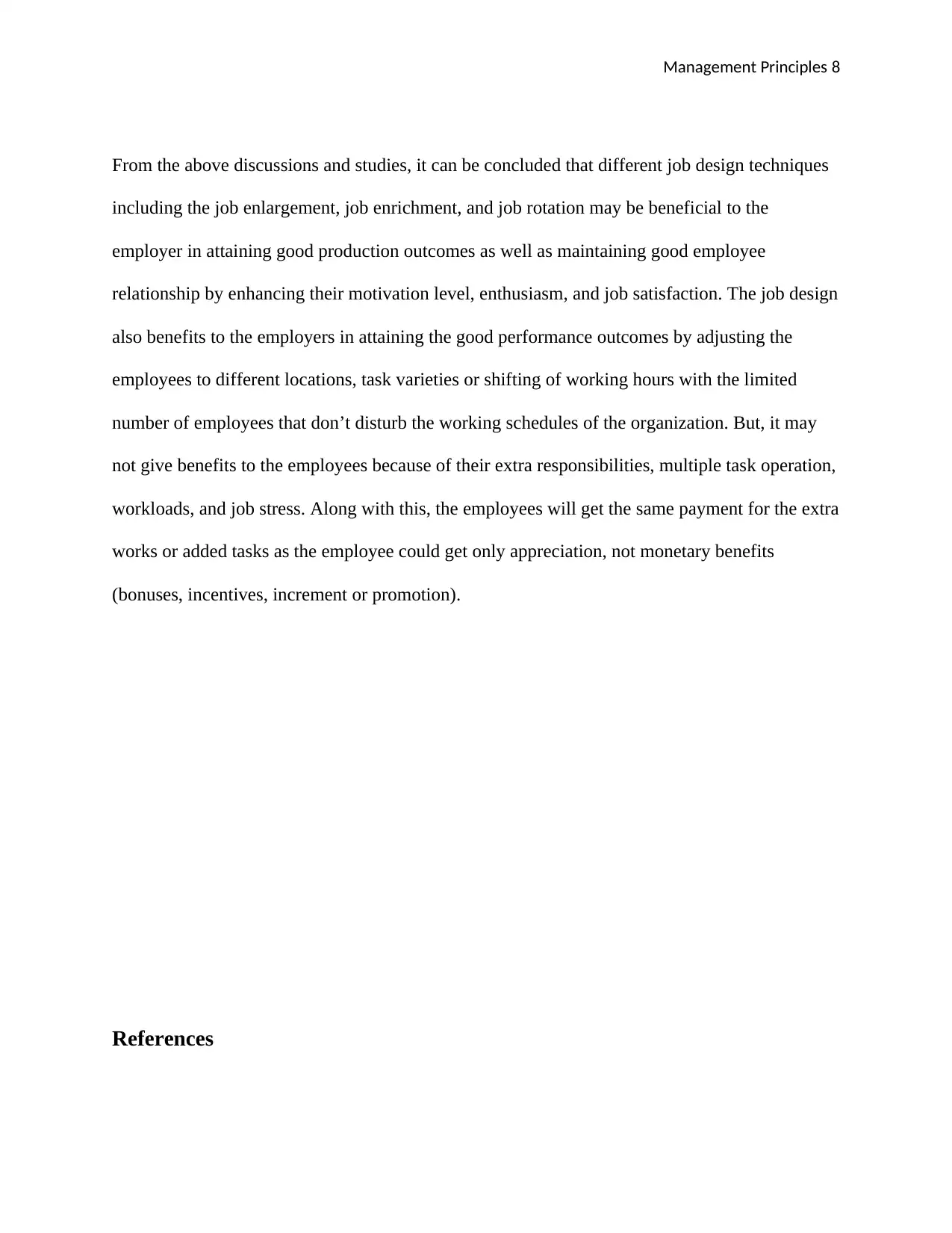
Management Principles 8
From the above discussions and studies, it can be concluded that different job design techniques
including the job enlargement, job enrichment, and job rotation may be beneficial to the
employer in attaining good production outcomes as well as maintaining good employee
relationship by enhancing their motivation level, enthusiasm, and job satisfaction. The job design
also benefits to the employers in attaining the good performance outcomes by adjusting the
employees to different locations, task varieties or shifting of working hours with the limited
number of employees that don’t disturb the working schedules of the organization. But, it may
not give benefits to the employees because of their extra responsibilities, multiple task operation,
workloads, and job stress. Along with this, the employees will get the same payment for the extra
works or added tasks as the employee could get only appreciation, not monetary benefits
(bonuses, incentives, increment or promotion).
References
From the above discussions and studies, it can be concluded that different job design techniques
including the job enlargement, job enrichment, and job rotation may be beneficial to the
employer in attaining good production outcomes as well as maintaining good employee
relationship by enhancing their motivation level, enthusiasm, and job satisfaction. The job design
also benefits to the employers in attaining the good performance outcomes by adjusting the
employees to different locations, task varieties or shifting of working hours with the limited
number of employees that don’t disturb the working schedules of the organization. But, it may
not give benefits to the employees because of their extra responsibilities, multiple task operation,
workloads, and job stress. Along with this, the employees will get the same payment for the extra
works or added tasks as the employee could get only appreciation, not monetary benefits
(bonuses, incentives, increment or promotion).
References
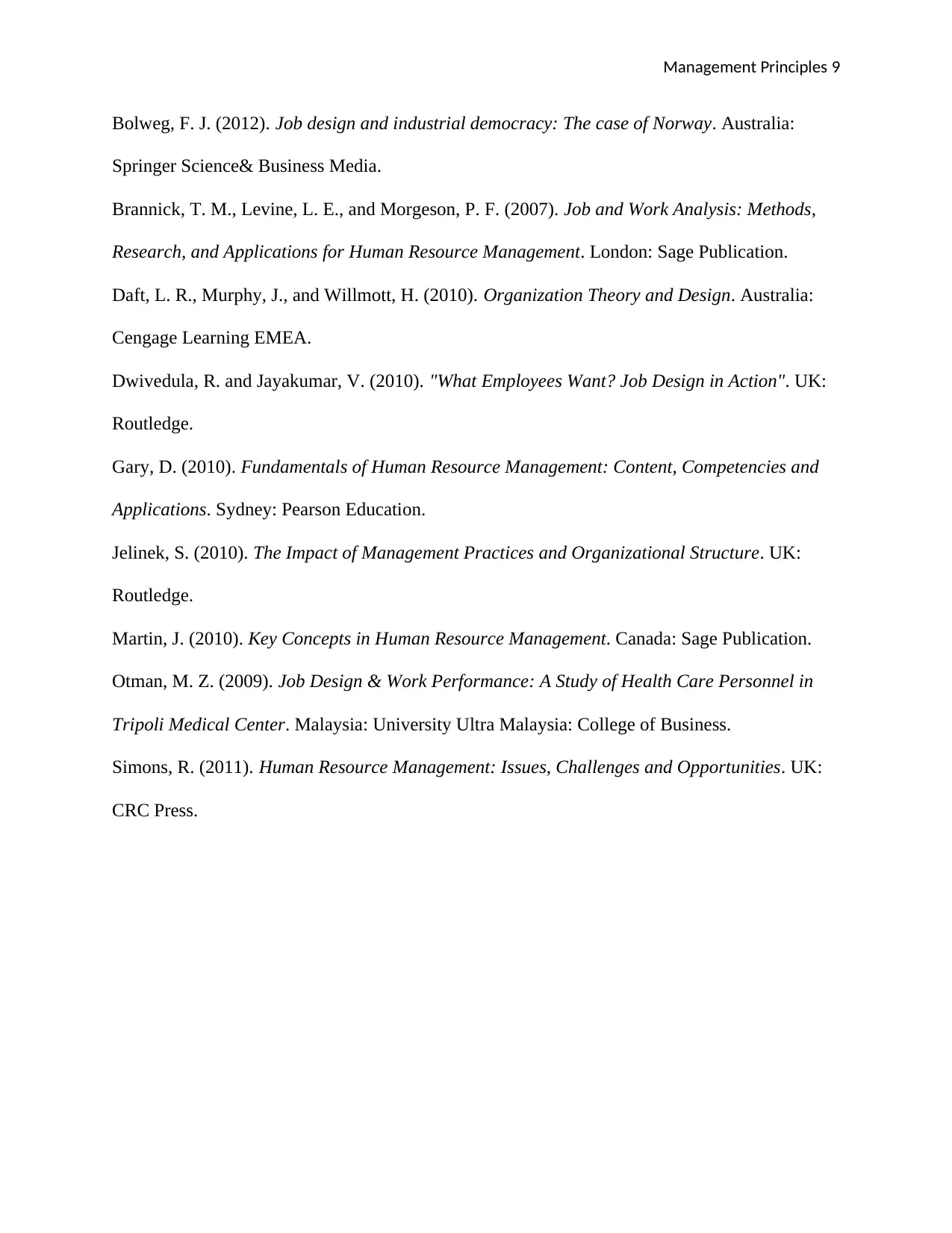
Management Principles 9
Bolweg, F. J. (2012). Job design and industrial democracy: The case of Norway. Australia:
Springer Science& Business Media.
Brannick, T. M., Levine, L. E., and Morgeson, P. F. (2007). Job and Work Analysis: Methods,
Research, and Applications for Human Resource Management. London: Sage Publication.
Daft, L. R., Murphy, J., and Willmott, H. (2010). Organization Theory and Design. Australia:
Cengage Learning EMEA.
Dwivedula, R. and Jayakumar, V. (2010). "What Employees Want? Job Design in Action". UK:
Routledge.
Gary, D. (2010). Fundamentals of Human Resource Management: Content, Competencies and
Applications. Sydney: Pearson Education.
Jelinek, S. (2010). The Impact of Management Practices and Organizational Structure. UK:
Routledge.
Martin, J. (2010). Key Concepts in Human Resource Management. Canada: Sage Publication.
Otman, M. Z. (2009). Job Design & Work Performance: A Study of Health Care Personnel in
Tripoli Medical Center. Malaysia: University Ultra Malaysia: College of Business.
Simons, R. (2011). Human Resource Management: Issues, Challenges and Opportunities. UK:
CRC Press.
Bolweg, F. J. (2012). Job design and industrial democracy: The case of Norway. Australia:
Springer Science& Business Media.
Brannick, T. M., Levine, L. E., and Morgeson, P. F. (2007). Job and Work Analysis: Methods,
Research, and Applications for Human Resource Management. London: Sage Publication.
Daft, L. R., Murphy, J., and Willmott, H. (2010). Organization Theory and Design. Australia:
Cengage Learning EMEA.
Dwivedula, R. and Jayakumar, V. (2010). "What Employees Want? Job Design in Action". UK:
Routledge.
Gary, D. (2010). Fundamentals of Human Resource Management: Content, Competencies and
Applications. Sydney: Pearson Education.
Jelinek, S. (2010). The Impact of Management Practices and Organizational Structure. UK:
Routledge.
Martin, J. (2010). Key Concepts in Human Resource Management. Canada: Sage Publication.
Otman, M. Z. (2009). Job Design & Work Performance: A Study of Health Care Personnel in
Tripoli Medical Center. Malaysia: University Ultra Malaysia: College of Business.
Simons, R. (2011). Human Resource Management: Issues, Challenges and Opportunities. UK:
CRC Press.
⊘ This is a preview!⊘
Do you want full access?
Subscribe today to unlock all pages.

Trusted by 1+ million students worldwide
1 out of 9
Related Documents
Your All-in-One AI-Powered Toolkit for Academic Success.
+13062052269
info@desklib.com
Available 24*7 on WhatsApp / Email
![[object Object]](/_next/static/media/star-bottom.7253800d.svg)
Unlock your academic potential
Copyright © 2020–2025 A2Z Services. All Rights Reserved. Developed and managed by ZUCOL.




